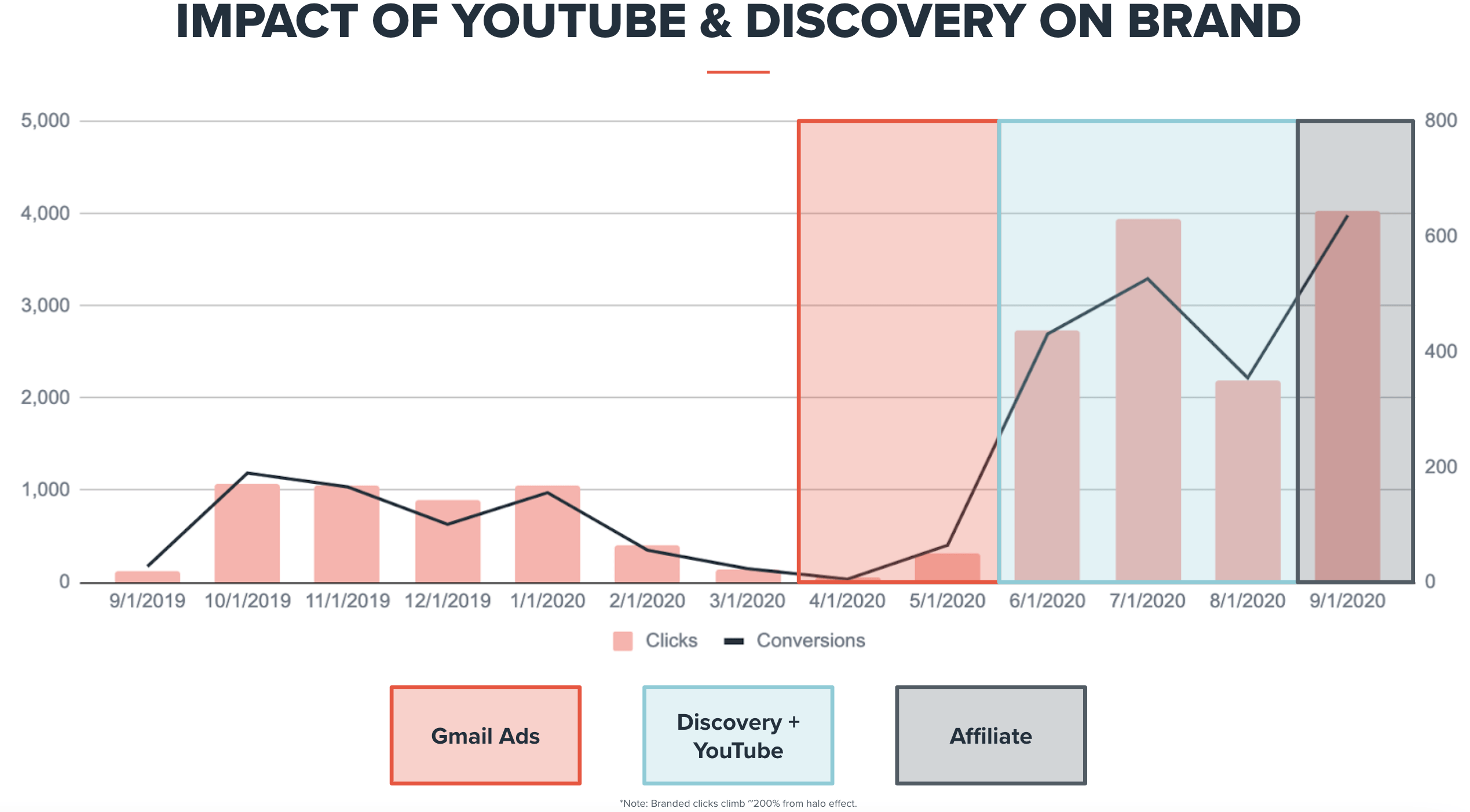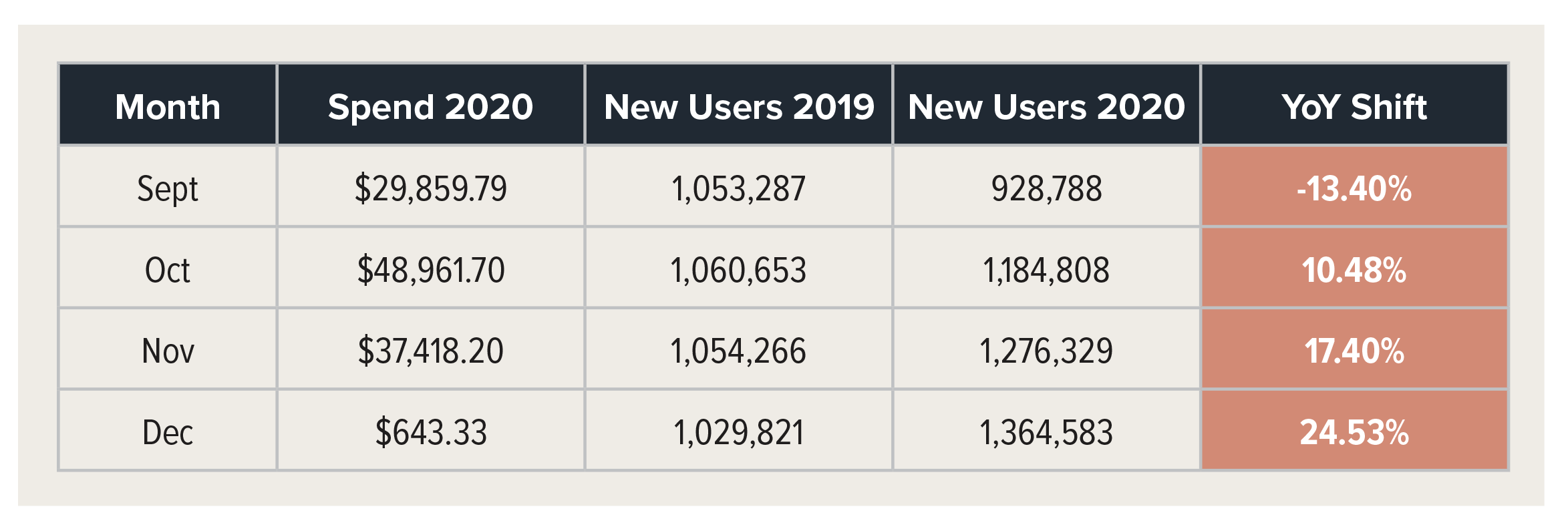Video has always been a powerful tool for marketers, but until recently that power was generally limited to upper-funnel efforts: driving mass reach, brand awareness, and consideration. For those looking to inspire action—a click, a purchase, a sign-up—email, search, and social were the mainstay channels.
But pandemic-induced shifts in consumer behavior have forever changed the role of online video: now it can help create demand—and capture it.
Online video marketing strategies will continue to expand across the entire customer journey—with brands leveraging the power of YouTube advertising to drive everything from awareness to direct response.
Upper funnel efforts on YouTube can also result in a halo effect on the lower funnel: the weight of a first impression in the awareness and consideration phase can significantly impact a person’s perception of a brand later down the funnel, even leading them to an eventual purchase decision.
Let’s explore what’s behind that shift, and how your brand can leverage the YouTube halo effect to leave a lasting impression on customers and maximize performance at every stage of the customer journey.
Why YouTube video advertising hasn’t always measured up to digital marketers’ expectations
In a digital age with real-time campaigns, data-driven decision making, and KPI-dependent budgets, performance marketers expect the results of YouTube video ads to naturally fall in line. But the truth is, YouTube ads are a different beast than ads on Google or Facebook.
Winning on YouTube requires a deep understanding of the customer journey and what success looks like (and how to measure it) across the funnel. We mapped out various consumer journeys to illustrate the typical steps a customer takes during their path to purchase.
 Any form of advertising that involves a click is easier to account for when it comes to attribution. View-based digital assets like banners and native ads seem to also have a measurable impact in most cases. The outlier? Traditional TV ads, where there’s no direct way for marketers to measure and quantify value.
Any form of advertising that involves a click is easier to account for when it comes to attribution. View-based digital assets like banners and native ads seem to also have a measurable impact in most cases. The outlier? Traditional TV ads, where there’s no direct way for marketers to measure and quantify value.
YouTube video ads exist somewhere in the middle of traditional media and digital direct response ads. They don’t necessarily result in an immediate click or purchase (which can make them difficult to fit into attribution models), but we have a lot more insight into how they’re working than we do with television ads.
Over the years, more and more ad options and tools have been developed to make deploying ad campaigns on the platform more actionable, optimizable, and measurable—proving that YouTube can be a profitable advertising tool if brands are willing to take the plunge.
How to overcome YouTube marketing measurement limitations and increase customer engagement
When a brand runs a Super Bowl ad, they’re guaranteed to see a huge lift in direct, paid, and organic traffic. Similarly, the halo effect of Youtube video advertising can reap similar benefits. Unlike a Super Bowl spot, however, YouTube ads won’t break the bank.
So how can YouTube ads help, and how do we quantify that impact? We analyzed a specific client’s paid search and media campaign to explore the potential impact of YouTube’s halo effect on brand performance:

As shown above, Client A’s investment in top-funnel tactics such as Discovery and YouTube ads led to a major brand lift (and subsequent conversions) later down the funnel:
- Conversion Rates: +2.46%
- CPA: -10.54%
- Clicks: +217%
In short, YouTube marketing was shown to have a significant lift beyond its measurable direct impact. Even if consumers didn’t take direct action immediately after engaging with a YouTube video ad, there was still a halo effect associated with that interaction that correlated with a boost in performance for lower-funnel campaigns.
There are three key takeaways here:
- If your ultimate goal is to grow your business, then you must be able to anticipate and capture customer intent at every stage of the funnel.
- Overlooking Discovery and YouTube because direct measurement isn’t perfect is no longer a valid excuse.
- It’s time to take advantage of YouTube as a strategic video marketing opportunity before your competitors beat you to it.
YouTube marketing best practices to put into action
Today, digital marketers have even more tools at their fingertips to test and optimize in real time, which means there are new opportunities to make the most of your digital ad dollars. Here are two essential ways better measurement, creative testing, and audience insights can boost the success of your next YouTube ad campaign—and help you win over new customers.
Drive new users to your site and prospect like a pro
Incrementality. Not only is it a fancy buzz word, but it’s also an essential component of realistic revenue goals for many brands—and YouTube is loaded with potential. If you are looking for a way to drive new users to your site over time, look no further:

In a period where we expected to see flat, or decreased, year-over-year (YoY) growth of new customers, investment in YouTube marketing helped turn things around.
Digital marketing success has always hinged on building meaningful customer connections. But the recipe for getting there—largely driven by data around consumer behavior—is constantly evolving. Here are the essential tips to help you better respond to changing consumer behaviors in your YouTube marketing strategy and drive prospects throughout the funnel:
- Approach brand and performance goals holistically
- Forward-thinking marketers have a built-in instinct for seeking out KPIs that signal the real impact on our bottom line, such as revenue and conversions. When pairing this mindset with consumer engagement associated with top-funnel tactics like YouTube, it can lead to higher success at every stage of the funnel.
- Tap into audience insights to reach your best customer
- Compelling, action-inspiring YouTube campaigns can help set your brand up for success. But if they aren’t reaching the right people, you likely won’t achieve the direct response goals you’re after. Developing a plan that leverages audience intent signals and high indexing in-market audiences and similar (also known as lookalike) audiences will help ensure that doesn’t happen.
- Meet your customer where they are in their journey
- Today’s savvy customers control their path to purchase, but YouTube advertising can create a compelling path for them to follow. Using YouTube’s video ad sequencing tool, you can develop campaigns across multiple ad formats to reach people at different touchpoints over time, based on their level of engagement.
- Improve measurement by adding ‘X network’ to Google Ads
- Enlisting in betas to improve YouTube performance and visibility can go a long way. It has helped us more than once deepen our understanding of where YouTube was 1) showing up and 2) impacting consumer journeys.
Re-engage long-lost customers and welcome them back into the fold
YouTube video marketing also is a great tool to re-engage customers. While looking at one outperforming YouTube remarketing campaign, we found that 80% of the conversions were from re-engaged customers.

First touch and only touch are audiences who have interacted with a brand in the past, but hadn’t done so in the past 30+ days. To get the best possible results out of a YouTube re-engagement strategy, follow these steps:
- Go after lapsed customers: These are visitors who haven’t interacted with your site for 30 days, 90 days, or 6 months, but have interacted with you in the past. You can rekindle their interest with YouTube campaigns.
- Use video metrics that make the most sense: An ad doesn’t have to generate a click to be effective, and this is particularly true for YouTube. For example, someone might see an ad for winter coats while browsing YouTube and decide to make a purchase later that day. These are called view-through conversions, and accurately accounting for them is important when calculating the ROI of your video campaigns.
- Connect the dots between upper-funnel video and search: 80% of people say they typically switch between online search and video when researching products to buy, according to a Google study, proving that upper-funnel videos can boost performance for your search campaigns. Plus, YouTube is constantly launching new formats targeting different results, like TrueView for action, which lets you automatically scale your video ads that drive action to more places on and off the platform.
Learn how to resolve four critical marketing paradoxes that hurt marketing performance with new guidance from Google, Michigan Ross School of Business, and Wpromote.







Responses